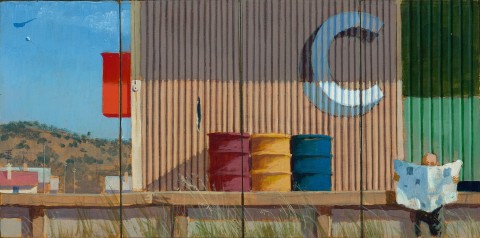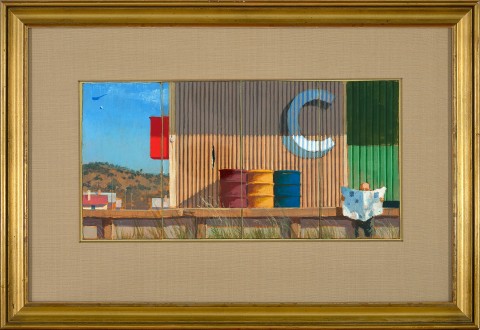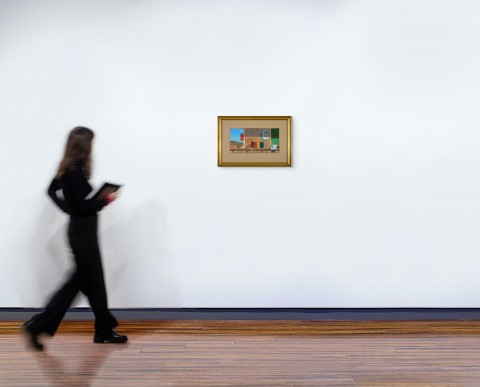SECOND SKETCH (POLYPTYCH) FOR MORNING, YARRAGON SIDING, 1983
JEFFREY SMART
synthetic polymer paint on Fabriano paper on card on composition board
polyptych (four sheets)
20.0 x 40.0 cm (overall)
Rex Irwin Art Dealer, Sydney (label attached verso)
Private collection, Bangkok, acquired from the above in 1984
Jeffrey Smart, Recent Paintings, Rex Irwin Art Dealer, Sydney, 6 – 24 November 1984, cat. 12
McDonald, J., Jeffrey Smart: Paintings of the '70's and '80's, Craftsman House, Sydney, 1990, cat. 261, p. 160
Morning, Yarragon Siding, 1983 – 84, oil and synthetic polymer paint on canvas, 100.0 x 134.0 cm, formerly in the Holmes à Court collection, Perth
Third Study for Morning, Yarragon Siding, 1983, oil on canvas, 28.0 x 39.0 cm, Parliament House Art Collection, Canberra
We are grateful to Stephen Rogers, Archivist for the Estate of Jeffrey Smart, for his assistance with this catalogue entry.
We are grateful to Brenda Martin Thomas, wife of the late David Thomas AM, for kindly allowing us to reproduce David's writing in this catalogue entry.
The Victorian country town of Yarragon nestles into the foothills of the Strezlecki Ranges. In Second Sketch for Morning, Yarragon Siding, 1983 Jeffrey Smart gives us a momentary glimpse of its rooftops and gently rolling hills bathed in sunlight, enveloped in an atmosphere so masterfully rendered that it seems tangible. Smart was visiting the area to make landscape studies for the Australian setting chosen for his monumental commission Container Train in Landscape, 1983 – 84 gifted to the Victorian Arts Centre, Melbourne by Marc and Eva Besen. While at Yarragon, the old railway shed on platform so captured Smart’s eye that he proceeded to explore the motif in two sketches on paper (including the present),as well as three oil studies and the larger final painting Morning, Yarragon Siding, 1983 – 84 (previously in the Holmes à Court collection, Perth).
While Smart’s final paintings are immaculate in composition and finish, as witnessed by the above-mentioned Morning, Yarragon Siding, his studies by contrast reveal an absorbingly immediate response to the motif. As such, they are often more personal by being so revealing. Indeed, the freer application of paint in Second Sketch for Morning, Yarragon Siding exudes an enthusiasm that Smart subsequently refined for the final work. Such initial enthusiasm allowed Smart the indulgence of an earlier fascination with texture, of timbers and other constructions, which contrasts starkly with the captivating plein-air quality of the landscape to the left. Painted in the tantalisingly traditional manner of Tom Roberts and the nineteenth-century Australian Impressionists, Smart thus juxtaposes nature with the contemporary world’s hard-edged realism in the siding and its hints of flat surfaced, geometric abstraction. Smart invites us to compare the two as equally worthy of consideration.
Like his artistic mentor Cézanne, Smart’s priority has always been the pursuit of the consummate composition and certainly, nowhere is this commitment to disegno or draughtsmanship more eloquently illustrated than in the evolution of Morning, Yarragon Siding. As the present sketch demonstrates, the carefully considered final composition – the crystallisation of a specific ‘moment of enchantment’ – was preceded by numerous experiments with key components including most notably the colours of the drums; the symbols on the corrugated shed; and the depiction of the figure with the newspaper. Although retaining many elements featured here, in the final oil painting the landscape is dominated by the construction and a stronger light; the lines and corrugations of the railway shed are more pronounced; and the colour composition is more sophisticated, bearing a greater formality. Interestingly, Smart would also eventually omit the curious detail of the Italian helicopter seen here in the distance with the underslung load (similarly appearing in the first oil sketch), and would replace the motif of the ‘C’ with the number ‘2’, thus designating the particular railway siding and providing the artist’s ultimate seal of approval through his happy addiction to including (often enigmatic) words and numbers in his paintings. As in music, the study and the finished painting here might be likened to a prelude and a concerto; both are excellent in their individual ways.
DAVID THOMAS


